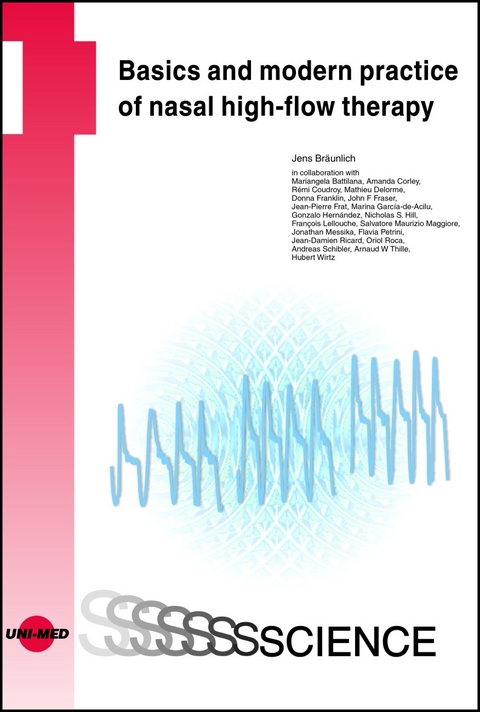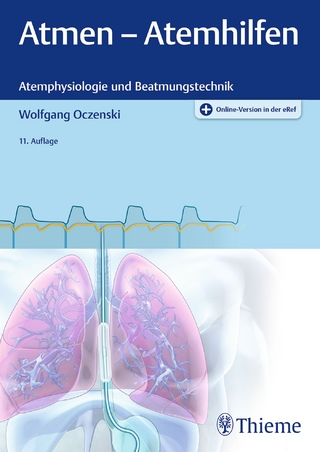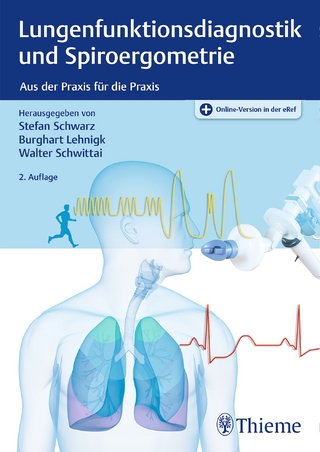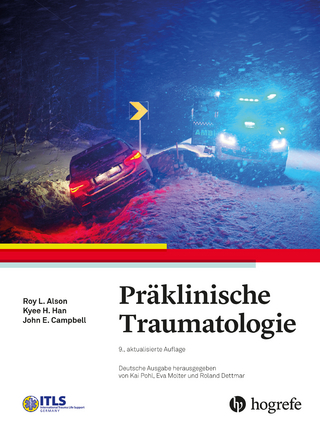
Basics and modern practice of nasal high-flow therapy
UNI-MED (Verlag)
978-3-8374-1569-8 (ISBN)
- Titel ist leider vergriffen;
keine Neuauflage - Artikel merken
1. Introduction 151.1. Pathophysiology of respiratory insufficiency 151.2. High- and low-flow oxygenation devices 151.3. Principles of mechanical ventilation 161.4. Role and limits of non-invasive ventilation 161.5. Rationale for the use of a NHF device 172. Nasal High-flow Devices 193. Mechanisms of Action 213.1. Humidification of the respiratory tract and comfort during NHF therapy 213.1.1. Introduction 213.1.2. Comfort during NHF 223.1.3. Humidification during oxygen therapy 223.1.3.1. Humidification during low- and medium-flow oxygen therapy 223.1.3.2. Humidification during high-flow oxygen therapy 233.1.3.3. Optimal humidification level during NHF 233.1.3.4. Performances of NHF devices 243.1.4. Conclusion 243.2. Changes in Upper Airway and Thoracic Pressures 263.3. Changes in ventilation and respiratory gases 273.3.1. Introduction 273.3.2. Reduction of functional dead space 283.3.3. Peak inspiratory flow coverage 293.3.4. CO2 rebreathing 303.3.5. Airway wash-out 303.3.6. Effects on the blood gases 313.3.6.1. Decarboxylation 313.3.6.2. Oxygenation with NHF systems 323.3.7. Conclusion 343.4. Changes in breathing patterns 363.4.1. Healthy subjects 363.4.2. Acute hypoxemic respiratory failure 363.4.3. COPD 383.4.4. Interstitial lung disease 393.4.5. Conclusion 403.5. Respiratory effort during nasal high-flow therapy 413.5.1. Introduction 413.5.2. Indicators of respiratory effort during NHF 423.5.3. Clinical markers of respiratory effort 423.5.4. Physiological markers of respiratory effort 433.5.4.1. In paediatrics 433.5.4.2. In adult patients in the acute setting 433.5.5. In adult patients in the chronic setting 453.5.6. In adult patients during sleep 453.5.7. Conclusion 454. Nasal High-flow Therapy in Infants and Children 494.1. Neonatal nasal high-flow 494.1.1. Physiological evidence of high flow in neonates 504.1.2. Evidence based efficacy of high-flow in premature infants 504.2. Pediatric high-flow 504.2.1. Definition of nasal high-flow in pediatric respiratory disease 514.2.2. Physiological principles of NHF therapy in children 514.2.3. Clinical evidence in pediatric respiratory disease 524.2.4. Authors recommendation 524.3. Conclusions 535. Nasal High-flow Therapy in the Management of Acute HypoxemicRespiratory Failure 555.1. Introduction 555.2. Pathophysiologic rationale NHF oxygen therapy in hypoxemic ARF 555.2.1. Oxygenation and PEEP effect 555.2.2. Ventilatory support 565.2.3. Comfort and humidification 575.3. Clinical impact of NHF oxygen therapy in hypoxemic ARF 575.3.1. Hypoxemic ARF 575.3.2. Immunocompromised patients 595.4. Conclusion 596. Nasal High-flow Therapy in Postextubation Respiratory Failure 636.1. Introduction 636.2. Risk factors and causes for postextubation respiratory failure 636.3. Pathophysiological mechanisms of postextubation respiratory failure 636.4. NHF role in postextubation respiratory failure 646.4.1. NHF after extubation in surgical patients in ICU 646.4.2. NHF after extubation in medical patients in ICU 676.5. Conclusions 717. Nasal High-flow Therapy in Specific Conditions and Diseases 757.1. Introduction 757.2. Emergency department 757.2.1. Important unknowns 777.2.2. Implication for future research 777.3. Apneic oxygenation/ intubation process 777.3.1. Important unknowns 787.4. Aerosol delivery 797.5. Fiberoptic bronchoscopy 817.5.1. Important unknowns 847.6. Palliative care 847.6.1. Important unknowns 847.7. Conclusion 858. Nasal High-flow Therapy in Hypercapnic Respiratory Failure 878.1. Introduction 878.2. Early physiological studies and retrospective evaluations 878.3. Prospective clinical trials 888.4. Effectiveness in decarboxylation and limitations 899. List of abbreviations 93Index 95
| Erscheinungsdatum | 05.04.2019 |
|---|---|
| Reihe/Serie | UNI-MED Science |
| Verlagsort | Bremen |
| Sprache | englisch |
| Maße | 179 x 249 mm |
| Gewicht | 326 g |
| Themenwelt | Medizinische Fachgebiete ► Innere Medizin ► Pneumologie |
| Medizin / Pharmazie ► Studium | |
| Schlagworte | high-flow therapy • Nasal high-flow therapy • NHF • Respiratory • Respiratory Therapy |
| ISBN-10 | 3-8374-1569-4 / 3837415694 |
| ISBN-13 | 978-3-8374-1569-8 / 9783837415698 |
| Zustand | Neuware |
| Haben Sie eine Frage zum Produkt? |
aus dem Bereich


